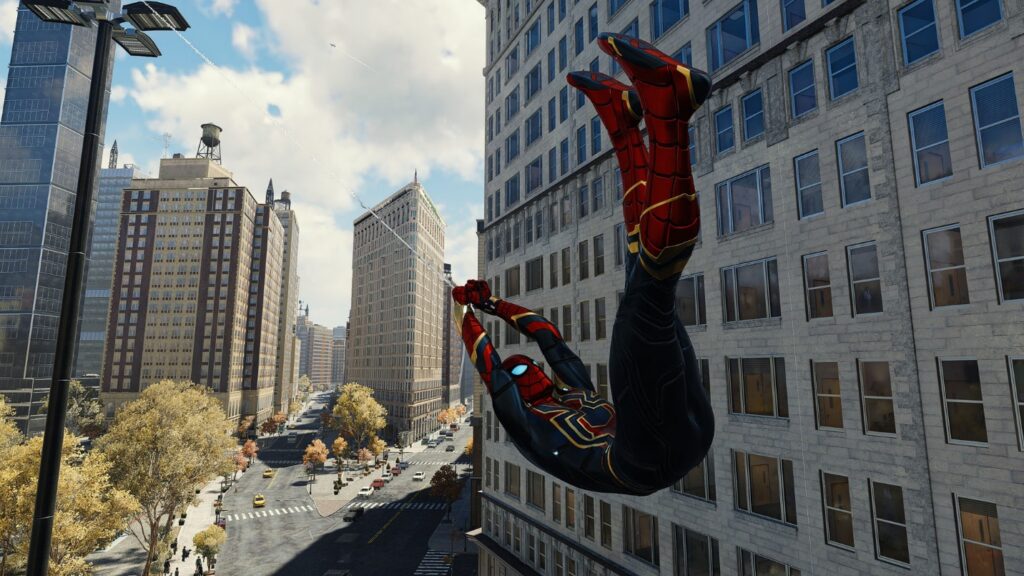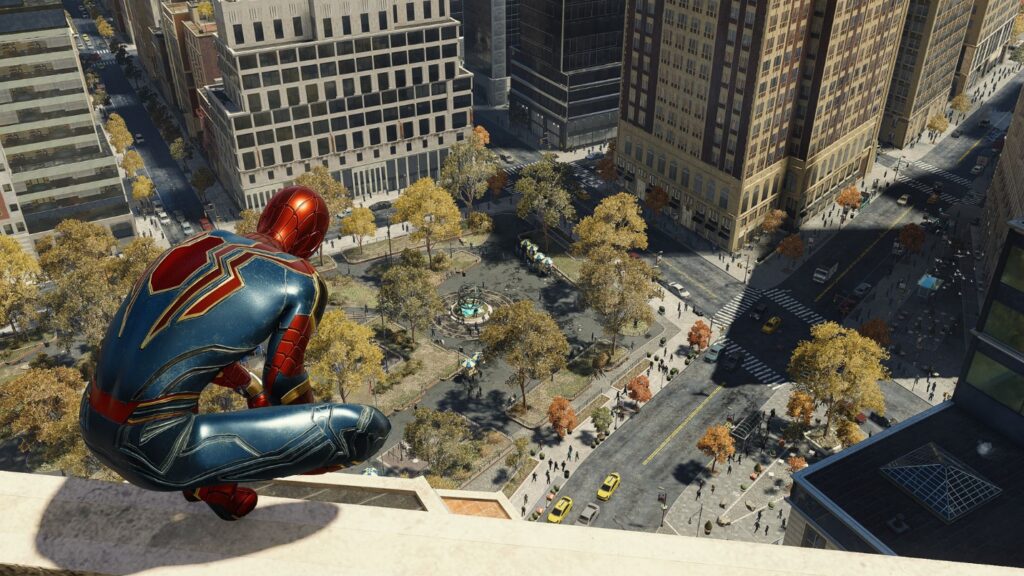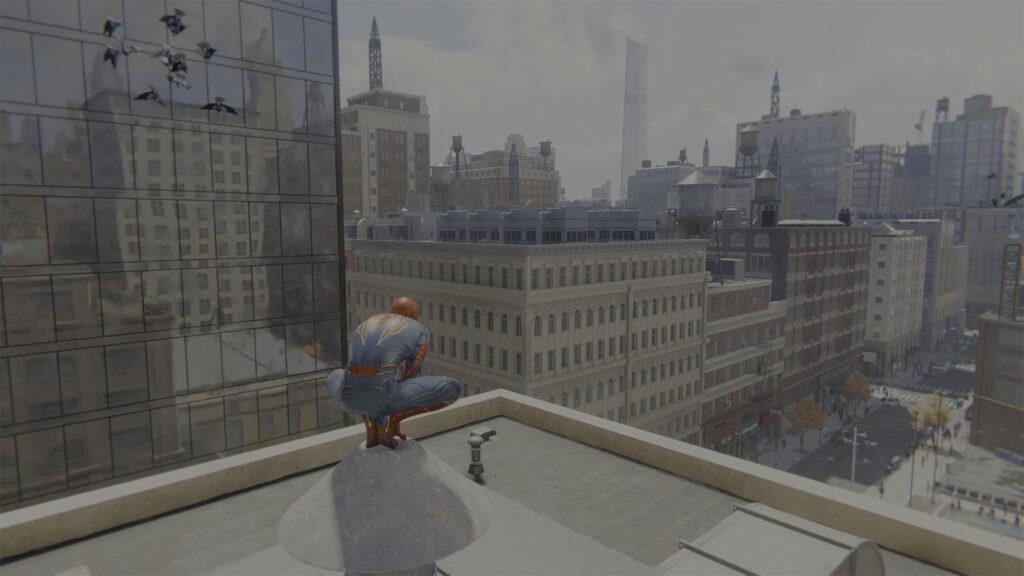Reviewers assess gameplay, performance, and image quality; conclude it is a game worth playing.
By Rodrigo González

After spending many hours completing Spider-Man Remastered main story and being unable to tear ourselves away from the screen, editors at BabelTechReviews (BTR) recommend it as a great game with a few flaws. Mark Poppin, Mario Vasquez, and I have collaborated on this review, each of us playing the game for 20 or more hours. We cover the gameplay, updated performance with Thursday’s patch, and IQ (image quality), which includes ray tracing and testing AMD’s and Nvidia’s upscaling solutions.
Spider-Man Remastered was released originally as a PS4 exclusive in 2018 and two years later was remastered for PS5. Sony then gave it a complete makeover when they ported it to the PC, complete with ray-traced reflections, and together with all the downloadable content, it was released on August 12, 2022. Sony worked quickly to patch the game six days later, significantly improving ray-traced performance while addressing bugs. We have tested the performance of 11 ray-tracing capable Nvidia and AMD cards because reflections add a lot of value to playing the game, much like the title Control does. Since Spider-Man Remastered is a fast-paced game, it’s important to keep frame rates high.
Before we proceed, let’s go under the hood. Spider-Man Remastered features anti-aliasing solutions SMAA, TAA, and Nvidia’s DLAA, as well as DLSS and AMD’s FSR 2.0 as upscaling solutions, to improve frame rates while maintaining image quality (IQ). DLAA is an Nvidia-developed superior AI-enhanced form of TAA, which has the best native render/display resolution visuals and is the best way to play on very powerful top RTX-powered PCs. As upscaling solutions, the DLSS Quality images are better than FSR 2.0 Quality with the camera in motion, and with DLSS Quality being as good as the native 4K visuals and slightly sharper. Unfortunately, there is no sharpening slider, and the overall images are too sharp.
FSR 2.0 is AMD’s latest iteration of FidelityFX Super Resolution. FSR improves performance by first rendering frames at a lower resolution and then by using an open-source spatial upscaling algorithm with a sharpening filter in an attempt to make the game look nearly as good as at native resolution. So far, there are 110-plus available and upcoming games supporting FSR 1.0 and FSR 2.0. Although FSR 2.0 is a solid improvement over 1.0, it is still outclassed by DLSS, especially with the camera in motion.
More than three years ago, Nvidia introduced real-time RTX ray tracing together with AI-powered Deep Learning Super Sampling (DLSS). To play at high settings requires the use of AI super-resolution, or DLSS, which provides better than a game’s post-processing of anti-aliasing together with improved performance. Spider-Man Remastered uses ray tracing with DLSS or FSR 2.0 to improve performance.

Rodrigo’s impressions
After completing the second act of the game’s main story arc, I recommend Spider-Man Remastered for the PC. So far, I have played for more than 20 hours and tested it for more than 30 hours. There are aspects I like a lot and a few I like less, but the final balance is very positive. About half the time, I played it on an Nvidia GeForce RTX 3080 at 1440p resolution with max settings, DLAA, and very high ray tracing. For the second act of the game, I used an AMD Radeon RX 6700 XT at 1080p with maximum settings, TAA, and no ray tracing.
First, I liked the narrative in the purest style of any Marvel superhero and villain movie. The story offers a good mix of emotions, frenetic action scenes, and somewhat trivial dialogs with light doses of humor, which, despite their simplicity, accompany the development of the main plot very well.

Second, I enjoyed its gameplay, which offers different styles, techniques, and combat movements. These include some that are more focused on melee-type approaches and fights to more strategic ones in which we can combine blows and the use of various “spider” combat gadgets, or even those that are purely stealth-based. It’s also great to use all of Spider-Man’s skills to fight enemies and discover, explore, and traverse the different areas of New York City. Swinging between buildings, doing stunts, or chasing or searching for targets is a delight. Spider-Man Remastered also offers some interesting side quests, adding more depth to the main story and increasing our playtime.

Regarding the development of our character, the game offers three trees of “arachnid” skills that we unlock and acquire by distributing skill points as we level up and earn experience points for our actions and by completing game missions. We can specialize more in a type of skill, but this may not make sense as the story progresses, and we likely end up developing all the skill trees to maximize our chances of success.
The graphical and visual section is also great, thanks to the graphics enhancements for adapting it to the PC gaming platform and the addition of real-time ray-traced reflections. Also noteworthy is the effort the developers put into re-creating in detail and bringing to life the different areas, icons, and monuments of New York City.

Spider-Man Remastered is gorgeous and fun to play. The performance optimization is pretty good overall. With an RTX 3080, I get 80-plus FPS on average at 1440p resolution, “maxed-out” settings, and ray tracing at very high settings with Nvidia DLAA. Frame-pacing is not perfect but decent overall, and the stutter count is pretty much zero (monitored via CapFrameX with RTSS) at all times during action gameplay (only capturing some minor stutters in menus and during cinematic sequences, but that’s very common in most games).
The RX 6700 XT was quite limited at 1440p. For this game, it’s an optimal card to play at 1080p with “Very High (16xAF)” settings but without ray tracing. With ray tracing (“High” or “Very High” settings) at 1080p, this card struggles quite a bit and shows FPS drops below 60, so you will have to resort to activating FSR 2.0 quality. However, any scaling method and setting (with or without ray tracing enabled) also comes with the issue of low GPU usage and a high CPU limitation when traversing the city outdoors. Therefore, for the overall smoothest experience, I recommend using the Radeon RX 6700 XT with “maxed-out” or “Very High (16xAF)” settings but without enabling ray tracing or FSR 2.0 scaling.
All in all, it’s a damn good game with a good narrative, story plot, and action gameplay, but for me, some collecting, grinding, and photography activities to improve our character and unveil the map felt somewhat repetitive. Overall, another good port from Sony, like Days Gone, God of War, or Horizon Zero Dawn.
However, the game still needs a few patches to achieve a stable state on most systems and fixes to some bugs and graphic glitches. Users with Nvidia and AMD graphics cards have reported occasional game crashes, freezes, or lockups during gameplay. So far, the game has crashed only three times for me, but it has never been game-breaking. Also, DLSS and FSR 2.0 settings don’t scale well on 1440p and lower resolutions due to low GPU usage and high CPU limitation when using these scaling methods.
Therefore, considering all the above, I rate it an 8 out of 10 as a very good game.
Mark’s comments
I agree that Spider-Man Remastered deserves at least an 8 out of 10 as a solid game. I played through the main quest within its first three days after the release in about 24 hours using first a BenQ 32-inch 4K display and then an LG C1 48-inch OLED 120 Hz display with an RTX 3080 Ti. The HDR was a bit too light, but otherwise, the game was very much like a great Spider-Man cinematic experience. I had a few more bugs than Rodrigo had—after all, I expected bugs from a day-one release Spider-Man game—but none of the relatively rare crashes to desktop lost progress.

I agree that the game’s main quest is great; it’s Spider-Man—and better than the movies and more like the comics. The map is shallow, and the enemies are all very similar, but I like the ability to use different moves and costumes and to build Spider-Man the way I wanted. The interplay between Spidey and MJ is great, as is the heartfelt, emotion-filled story about Miles and his hero dad. Surviving loss was well explored, and even the motivations of the villains were detailed. Voice acting and audio are epic, and they add to the enjoyment and immersion into Spider-Man’s world.
Spider-Man Remastered is a solid PC port with a very good implementation of keyboard and mouse. Only once during a museum puzzle did I resort to using a controller. The reflections are outstanding and exist everywhere in puddles, shiny floors, and in the glass skyscrapers that reflect light naturally. Reflections make the game come to life, and there is a real sense of loss when ray tracing is turned off.

I did not like many of the mundane side quests (‘the city is burning but save my pigeons’) and I skipped or left many unfinished except for the electrical/spectrograph puzzles which I am good at and really liked. On the other hand, Mario played the game on the PS5 and loved the side quests that introduce a plethora of characters which he said added to the story of your friendly neighborhood Spider-Man.
Mario’s comments
One-liners and boss battles are incredible and fun—it’s what the studio is known for—and there are great set pieces but with uninspired goons in between. The actual named characters are great, and the MJ and Miles stealth missions were a nice change of pace but could annoy some gamers. It is silly that Spider-Man can stand there and “finish” goons while their buddies just watch, and it was unnecessary to change Spidey’s look to mimic Tom Holland. And although the voice acting is great, Miles Morales’ voice (as Spider-Man) is beyond wrong.
The PS5 has some issues and the game on it could look way better—as proven with the PC release—and I look forward to playing it again on the PC. For instance, the textures aren’t nearly as nice as they are on the PC. In comparison, they can look washed out and missing some visual fidelity. The game deserves 8/10 as the definitive superhero game on the console and PC. They took everything that worked for Batman and made it better for a young, fun Spider-Man, with an amazing supporting cast to boot.
Conclusion
Spider-Man Remastered is an immersive, outstanding, and really fun game that gives a great cinematic experience while telling an extraordinary story. We are especially impressed by its visuals coupled with the large, free performance increase that DLSS and FSR 2.0 brings for PC gamers.
If you like Spider-Man movies and/or comics, Remastered is a must-play game that is better than the films. And if you are looking to play the game with the best frame rates and the very highest image fidelity, then choose DLSS or FSR 2.0, depending if you are a GeForce or Radeon gamer. Spider-Man Remastered is the kind of deeply immersive game that makes a player forget everything—food, chores, work, and even pain.
BTR’s three editors agree that Spider-Man Remastered is a very good game that deserves at least an 8/10. Recommended!
For a full review of the game title, including extensive performance options and in-depth benchmarking of multiple graphics cards, see “Spider-Man Remastered updated performance review featuring IQ & ray tracing” on the BTR website.





